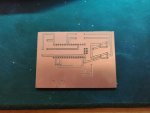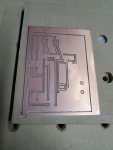- Messages
- 16,581
- Location
- Reno NV
So, I do like playing around with electronics and have experimented in making my own pcb's with the laser. That method has worked for me, but I really don't like drilling all the holes.
So here's my latest experiment, milling out a pcb on my CNC machine.
This is my best attempt so far, but I still need to work a bit on some auto leveling code. You can see how the traces in the lower right of middle did not get cut all the way through.
But, getting close. I can probably also condense this design down a bit.
Also need to get some better bits, but I'm not unhappy with how this is turning out so far...

So here's my latest experiment, milling out a pcb on my CNC machine.
This is my best attempt so far, but I still need to work a bit on some auto leveling code. You can see how the traces in the lower right of middle did not get cut all the way through.
But, getting close. I can probably also condense this design down a bit.
Also need to get some better bits, but I'm not unhappy with how this is turning out so far...


